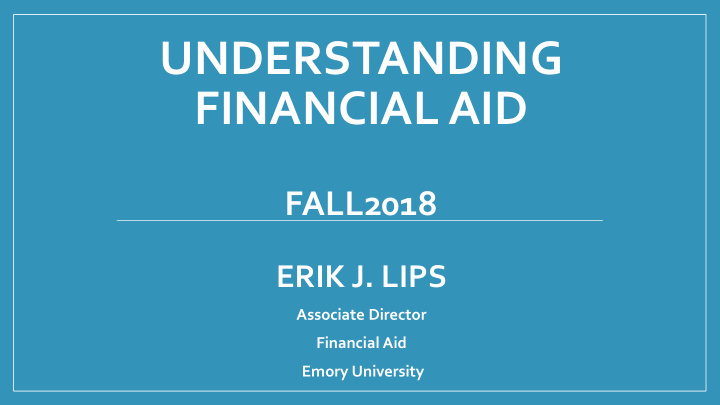



UNDERSTANDING FINANCIAL AID FALL2018 ERIK J. LIPS Associate Director Financial Aid Emory University
One Student, Many Outcomes Need Based Merit Based Discounting Program Enticements • Honors Program • Instate tuition cost • Faculty connection/Lab work/Research Programs • Dual Degree (Value added) Programs: Combined BA/MA ZIP, NADA, 0, NULL SET, NOTHIN’ (But it’s never really zero -summer employment, school year employment, student and parent loans)
Philosophy Behind Need Based Aid Goals of Need-Based Aid: Access Fit Choice • Families contribute to the extent they’re able, and have primary responsibility • Need-based aid programs emphasize fairness and equity across the entire population • Income and assets reflect a family’s financial strength • Higher contributions expected from those with greater financial resources • Unusual financial family circumstances may be considered “Ability to pay vs. willingness to pay”?
Two Types of Financial Aid Gift Aid Self-Help Aid Financial Aid that does not require Financial Aid provided through the payment or work to be performed. work and effort of the student Examples: Examples: - Scholarships (Merit: Awarded for talent, - Federal Direct Loans (Student Loans athletics or academic credentials) fixed 5.05% for 2018-19) - Grants (Typically need-based: Federal, Parent PLUS Loans 7.6% State, and Institutional) - Student Employment/Work Study
Need Based Aid Basics Primary Secondary Parent Prior Tax Info Contribution: Income & State Assets Family Size Student Number in College Contribution: Income & Assets
FAFSA www.fafsa.ed.gov • The FREE APPLICATION for FEDERAL STUDENT AID (FAFSA) • Available October 1 of the student’s Senior Year • For the 19-20 school year, 2017 tax data will be needed to complete the application • Uses parental, student income and assets to generate the Expected Family Contribution (EFC) • Used in all Federal Funds awarding • PELL, SEOG, Perkins Loans, Direct Federal Loans, Work Study, etc. • Step 1: www.FSAID.ed.gov obtain your federal student aid ID (both parent and student)
CSS Profile www.collegeboard.com • Used by organizations and mainly Private Universities to award nonfederal student aid funds • Mainly, Private Institutional Grants • $25 Fee for initial application and one college (or program report) • Additional reports are $16 • Completing Online requires a valid credit card or checking account • Fee waivers are granted automatically — based on the information entered on the PROFILE application • Available October 1 of the student’s Senior Year
Non-Custodial Parent PROFILE (HHB) • When marital status of the biological or adoptive parents is separated, divorced, or never married (FAFSA doesn’t ask for NC information) • Waivers should be pursued where abuse, a restraining order, incarceration, or total disability, etc. exists. • documentation is necessary • Unwillingness is not a reason for a university to waive their requirement • Students need to be proactive and adhere to posted deadlines
Estimated EFC Chart
How Financial Need Varies Based on Cost The difference between COA and EFC, the resulting amount may be fully or partially accounted for with gift and/or self-help aid. COA – EFC = NEED 1 X 2 Y 3 Z EFC EFC Cost of Expected Family Need Attendance Contribution (Variable) (Variable) (Constant)
Net Price Calculator • Final results display to help the family understand the break down of costs • Drawbacks? $27,626 • Merit awards are rarely presented • Income information (garbage in, garbage out) $35,876 • Family still needs to apply for aid (on time) • 150k family, 200k home equity, 50k cash
Quick and easy tool: MyinTuition • www.myintuition.org • Quick and easy tool to understand affordability • Emory University example • $150,000 family • $200,000 Home Equity • $50,000 cash/investments
Results
Another Outcome
What is Merit Aid? Academic Athletic Talent Demographics
Merit Aid, the basics • Eligibility for Merit Awards ▪ Application processes will vary greatly by school • With Admission Application?? • Nomination by High School/College invite?? ▪ Criteria will depend on the objectives of the awarding entity ▪ Colleges/Universities ▪ Online/Local Organization Scholarship Awards ▪ The more selective the institution, fewer (if any) merit-based awards exist
Emory Scholars Program • Application Deadline is November 15 th • Even if applying Regular decision (Jan 1) the application must be submitted by Nov. 15 to be considered • Self Nomination • Just check the Emory Scholar box on the admission application • Student will be considered for the MLK (APS schools only) and Woodruff Scholarship • Total award covers tuition, fees, room and board. • For 2018-2019 this totaled: $68,812
One Student, Many Outcomes Need Based Merit Based Discounting Program Enticements • Honors Program • Instate tuition cost • Faculty connection/Lab work/Research Programs • Dual Degree (Value added) Programs: Combined BA/MA ZIP, NADA, 0, NULL SET, NOTHIN’ (But it’s never really zero -summer employment, school year employment, student and parent loans)
Questions??
Popular Scholarship Search Engines • www.Cappex.com • www.scholarshipexperts.com • www.Scholarships.com • www.NerdWallet.com • www.fastweb.com • www.niche.com
Recommend
More recommend